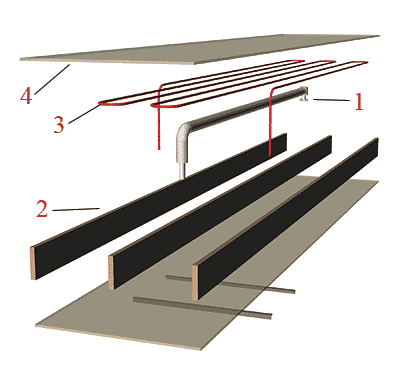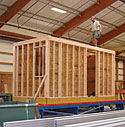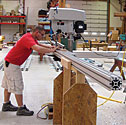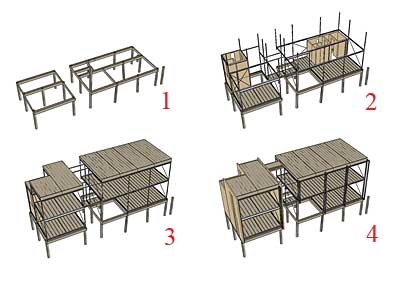Loblolly House: In Stock and Ready to Ship
"It's elementary, my dear" architecture
The Bosch frame sits on pilings that were put in place over three days in February 2006 during initial site work. According to Chip Arena, the construction manager, the site needed extensive stabilization, since it's almost a marshland in consistency. Soggy grass notwithstanding, the exposed waterfront site explains why the Loblolly House stands on pilotis, though Kieran says hurricane-style flooding is extremely rare on the island. Arena oversaw site utility work, as well as construction of the timber frame connecting the pilings as a base for the Bosch system.
|
| Each smart cartridge (above) for the floor contains building systems that terminate at connectors, which then tie into main service channels on each floor and back to mechanical-room blocks, where the systems "quick-couple" into supply units. |
The site, a fragile ecosystem and one of the best places in the country to see bald eagles, benefited from the fact that little area for storage of materials or for staging was required, as elements arrived on-site in a just-in-time-for-assembly manner. The project's swift construction schedule began in late September; on October 4, for example, during a site visit by Kieran, assemblers from Bensonwood unloaded and, with a small crane, placed the roof on the house in nearly 20 minutes. (Kieran intends to plant a sedum green roof in the spring.)
The roof and floors consist of 19 cartridges, which were the main elements fabricated in New Hampshire by Bensonwood and by far the most complex technological innovation of the house. KTA segmented the cartridges into two types: smart, containing radiant heating pipes, electrical distribution and outlets, cooling microducts, and insulation; and dumb, containing only insulation. Both types of cartridges basically consist of standard sheets of plywood (to ease construction and maintain the modular nature of the elements) sandwiched together with conventional wood two-by-fours. The cartridge design also allows access areas for future maintenance.
|
The smart cartridges, used exclusively for the floor, have utility "whips" that tie into a main supply channel on each of the two occupied floors of the house, eventually connecting to mechanical rooms on either end. The mechanical-room blocks, as well as the bathrooms and kitchen, arrived on-site fully framed and nearly finished, moved by crane into place to await final connection. Dumb cartridges make up the exterior walls and hang so the aluminum frame remains on the interior to prevent exposure to moisture. Cement board attached to the exterior face of the cartridges seals the house, while a varied pattern of cedar boards agglomerated into units clip onto the frame, acting as a rain screen and aesthetically nodding to nearby loblolly pines. On-site contractors will fill in gaps from the prefab process, such as putting down the green-dyed bamboo flooring in the main living areas and ceramic tile in the bathrooms. (Bensonwood declined to do both finish items in its shop because of shipping concerns.)
Bensonwood, best known for producing and erecting residential timber frames, but not the houses themselves, retooled its assembly line to fabricate the cartridges and the modules. Hans Porchitz, Bensonwood's project manager, says once he and his colleague's understood KTA's ambition, as well as the details of how every component would interconnect, production of each element went from raw wood stock to finished material with a click of a button as the CadWorks model directly fed the company's computer numerical control, or CNC, machines. Bensonwood's fabricators, as well as subcontractors, like electricians and plumbers (a first for the company), then assembled the materials into the elements for final delivery.














